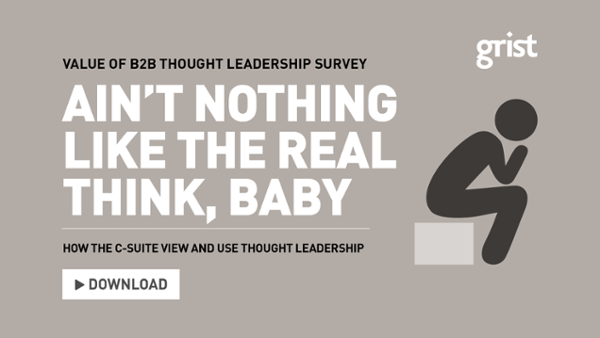With our Value of B2B thought leadership survey, we wanted to understand how senior executives consumed thought leadership content and what they wanted from it. There are many takeaways that will make your thought leadership marketing better, but in this blog we focus on the ‘five Ws’: the who, what, where, when and why.
Who
We surveyed 525 senior executives at enterprise firms around the world and asked them: When reading thought leadership, whose views do you want to hear? The top answer was the views of their customers (62%). This was echoed in our previous survey in 2016.
Competitors or peers came in second with 48%, while industry experts (44%) and inspirational individuals outside the industry (41%) also feature high.
All this suggests the C-suite is interested in hearing from people outside of their immediate circle – those people that their company exists to help and those who can provide outside perspectives.
However, perhaps most interestingly, more than a third (34%) of the C-suite we talked to wants to hear from advisory firms that specialise in the issue. These are the very firms that want to reach the C-suite with their thought leadership.
What
Our research found 68% of senior executives want thought leadership to give them an edge over competitors, while 66% say they want it to keep them informed of emerging trends. The third most popular answer is to enable them to make better decisions (64%).
All three of these responses encapsulate the fundamental objective of all successful content marketing – to be of use.
Comparing these results with our 2016 research shows how the value of thought leadership is changing. In 2016, only 48% of senior executives surveyed claimed to read thought leadership to give them an edge over competitors – now up 20%. Similarly, helping answer their most pressing problems rose 15%, with 54% now stating that’s why they read thought leadership. Commercial objectives are clearly competing for attention with future trends.
Yet the most notable change since 2016 is that 57% of respondents read thought leadership to help evaluate the expertise and insight of the adviser that created it. Compare this with the 36% from 2016 and the importance of thought leadership is clear. It’s no longer a ‘nice-to-have’, but a ‘must-have’.
Where
According to our survey, professional networks (eg colleagues or peers) are the go-to source for seeking out thought leadership, with 57% of respondents citing it as number one.
Second on the list is online search (42%). With this in mind, it’s essential to incorporate SEO and social media strategies when creating your thought leadership campaigns.
Noticeably, 41% of the C-suite we surveyed say they seek out thought leadership from professional services/advisory firms. This should be a green light for those firms to invest in creating the content their clients are showing an appetite for.
When
Monday (55%) proves to be the most popular day for the C-suite to seek out thought leadership, by some distance. Wednesday is the second favoured day with 47% but, other than Monday, the difference in weekdays is negligible. Less surprising is the weekend being when they are least likely to be looking for thought leadership. Believe it or not, senior executives like to avoid work at the weekends too.
If Monday is the most popular day to seek out thought leadership, the first half of the day is the most popular time, with the majority saying they are most likely to view thought leadership between 9am and 2pm (66%). Only 14% will seek it later in the workday (2pm to 6pm). Something to keep in mind for your social media activity.
Why
Our research reveals some very compelling reasons why you shouldn’t miss out on the opportunity thought leadership provides. For one, 99% of the senior executives we surveyed said thought leadership was either critical or important to their decision-making when appointing an adviser.
Anecdotal evidence would back this up. Take RFPs, for example. Whereas thought leadership used to be something that could add value to your proposal, it has now become expected. If we accept that thought leadership is now the norm, however, there is even more importance on getting it right.
For more insights, download the full report:



